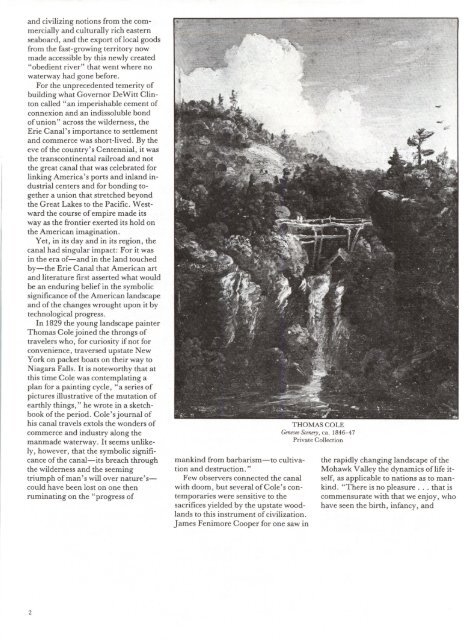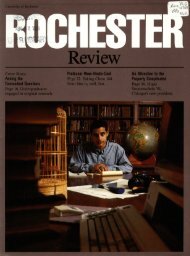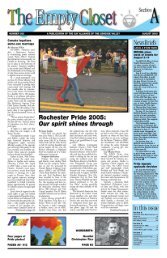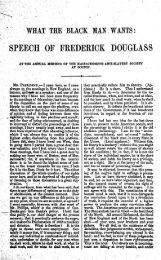Download PDF - University of Rochester Libraries
Download PDF - University of Rochester Libraries
Download PDF - University of Rochester Libraries
Create successful ePaper yourself
Turn your PDF publications into a flip-book with our unique Google optimized e-Paper software.
and civilizing notions from the commercially<br />
and culturally rich eastern<br />
seaboard, and the export <strong>of</strong> local goods<br />
from the fast-growing territory now<br />
made accessible by this newly created<br />
"obedient river" that went where no<br />
waterway had gone before.<br />
For the unprecedented temerity <strong>of</strong><br />
building what Governor DeWitt Clinton<br />
called" an imperishable cement <strong>of</strong><br />
connexion and an indissoluble bond<br />
<strong>of</strong> union" across the wilderness, the<br />
Erie Canal's importance to settlement<br />
and commerce was short-lived. By the<br />
eve <strong>of</strong> the country's Centennial, it was<br />
the transcontinental railroad and not<br />
the great canal that was celebrated for<br />
linking America's ports and inland industrial<br />
centers and for bonding together<br />
a union that stretched beyond<br />
the Great Lakes to the Pacific. W estward<br />
the course <strong>of</strong> empire made its<br />
way as the frontier exerted its hold on<br />
the American imagination.<br />
Yet, in its day and in its region, the<br />
canal had singular impact: For it was<br />
in the era <strong>of</strong>-and in the land touched<br />
by-the Erie Canal that American art<br />
and literature first asserted what would<br />
be an enduring belief in the symbolic<br />
significance <strong>of</strong> the American landscape<br />
and <strong>of</strong> the changes wrought upon it by<br />
technological progress.<br />
In 1829 the young landscape painter<br />
Thomas Cole joined the throngs <strong>of</strong><br />
travelers who, for curiosity if not for<br />
convenience, traversed upstate New<br />
York on packet boats on their way to<br />
Niagara Falls. It is noteworthy that at<br />
this time Cole was contemplating a<br />
plan for a painting cycle, "a series <strong>of</strong><br />
pictures illustrative <strong>of</strong> the mutation <strong>of</strong><br />
earthly things," he wrote in a sketchbook<br />
<strong>of</strong> the period. Cole'sjournal <strong>of</strong><br />
his canal travels extols the wonders <strong>of</strong><br />
commerce and industry along the<br />
manmade waterway. It seems unlikely,<br />
however, that the symbolic significance<br />
<strong>of</strong> the canal-its breach through<br />
the wilderness and the seeming<br />
triumph <strong>of</strong> man's will over nature'scould<br />
have been lost on one then<br />
ruminating on the "progress <strong>of</strong><br />
2<br />
mankind from barbarism-to cultivation<br />
and destruction. "<br />
Few observers connected the canal<br />
with doom, but several <strong>of</strong> Cole's contemporaries<br />
were sensitive to the<br />
sacrifices yielded by the upstate woodlands<br />
to this instrument <strong>of</strong> civilization.<br />
J ames Fenimore Cooper for one saw in<br />
THOMAS COLE<br />
Genesee Scenery, ca. 1846-47<br />
Private Collection<br />
the rapidly changing landscape <strong>of</strong> the<br />
Mohawk Valley the dynamics <strong>of</strong> life itself,<br />
as applicable to nations as to mankind.<br />
"There is no pleasure ... that is<br />
commensurate with that we enjoy, who<br />
have seen the birth, infancy, and
















